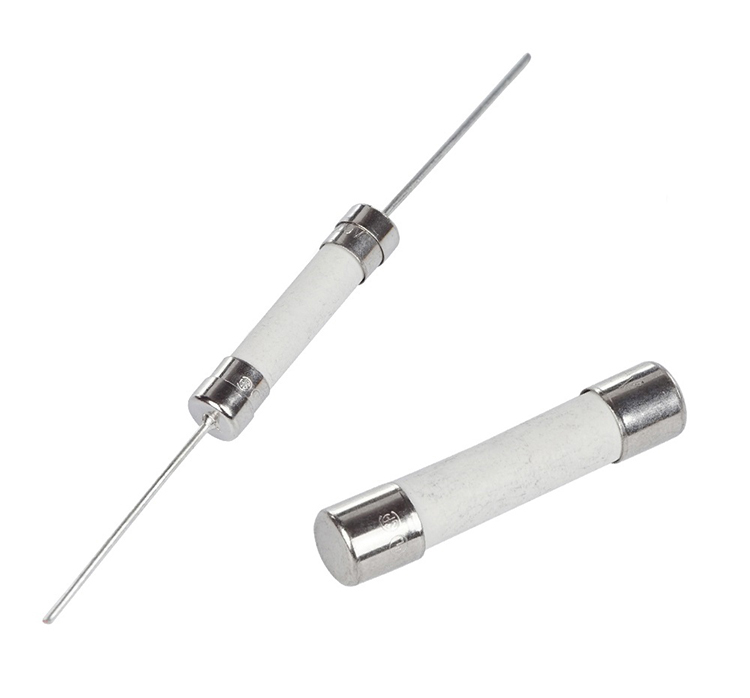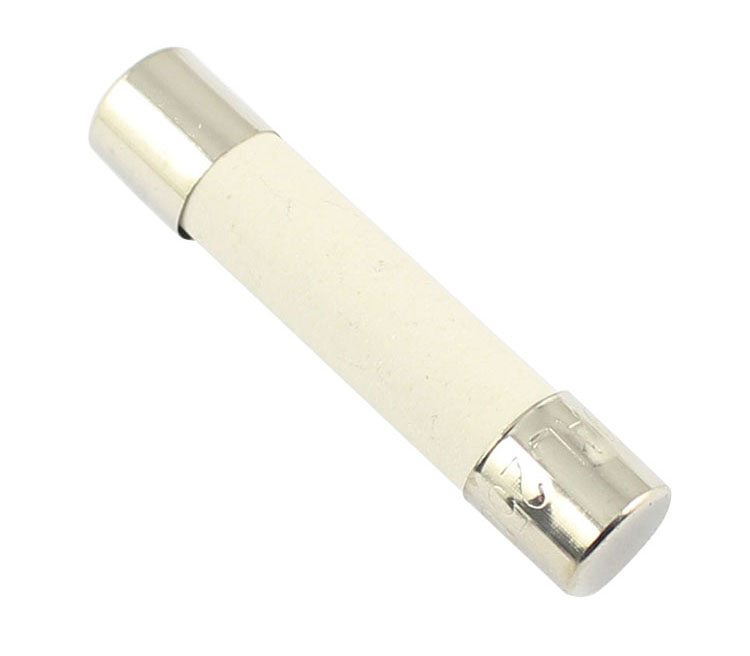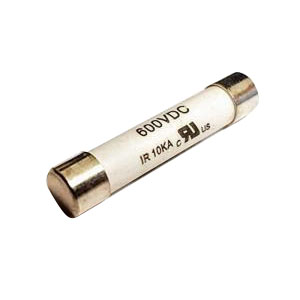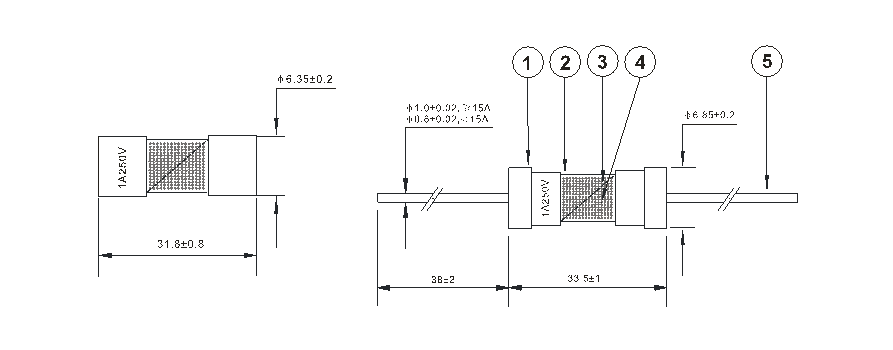Lead Fast Acting Ceramic Fuse
6.35x32mm Leaded Quick Acting Ceramic Fuse F3A250V For Overcurrent Protection
Features Of Lead Fast Acting Ceramic Fuse
UL CUL Certificated
Without lead or axial leaded
Rated voltage 250V
Wide current range 100mA ~ 50A
Breaking Capacity:
35A at 250V AC (BMF In range 100mA~1A);
100A at 250V AC (BMF In range 1.25A~3.5A);
200A at 250V AC (BMF In range 4A~10A);
750A at 250V AC (BMF In range 12A~30A)
1000A at 250V AC (BMF In range 32A~50A)
Customs number 8536101090



Application Of The 6.35x32mm Quick Lead Fast Acting Ceramic Fuse
Protection of Multimeter
For short circuit protection only
Size Of The 6.35x32mm Lead Fast Acting Ceramic Fuse (mm)

Specification Of The 6.35x32mm Lead Fast Acting Ceramic Fuse
|
Catalog
No.
|
Ampere
Rating
|
Voltage
Rating
|
Breaking
Capacity
|
Agency Approvals
|
|

|

|
|
BMF0100A
|
100mA
|
250V
|
35A@250V AC (100mA~1A);
100A@250V AC (1.25A~3.5A);
200A@250V AC (4A~10A).
750A@250V AC (12A~30A).
1000A@250V AC (32A~50A)
|
●
|
●
|
|
BMF0160A
|
160mA
|
250V
|
●
|
●
|
|
BMF0200A
|
200mA
|
250V
|
●
|
●
|
|
BMF0250A
|
250mA
|
250V
|
●
|
●
|
|
BMF0300A
|
300mA
|
250V
|
●
|
●
|
|
BMF0315A
|
315mA
|
250V
|
●
|
●
|
|
BMF0350A
|
350mA
|
250V
|
●
|
●
|
|
BMF0400A
|
400mA
|
250V
|
●
|
●
|
|
BMF0500A
|
500mA
|
250V
|
●
|
●
|
|
BMF0630A
|
630mA
|
250V
|
●
|
●
|
|
BMF0750A
|
750mA
|
250V
|
●
|
●
|
|
BMF0800A
|
800mA
|
250V
|
●
|
●
|
|
BMF1100A
|
1A
|
250V
|
●
|
●
|
|
BMF1125A
|
1.25A
|
250V
|
●
|
●
|
|
BMF1150A
|
1.5A
|
250V
|
●
|
●
|
|
BMF1160A
|
1.6A
|
250V
|
●
|
●
|
|
BMF1200A
|
2A
|
250V
|
●
|
●
|
|
BMF1250A
|
2.5A
|
250V
|
●
|
●
|
|
BMF1300A
|
3A
|
250V
|
●
|
●
|
|
BMF1315A
|
3.15A
|
250V
|
●
|
●
|
|
BMF1350A
|
3.5A
|
250V
|
●
|
●
|
|
BMF1400A
|
4A
|
250V
|
●
|
●
|
|
BMF1500A
|
5A
|
250V
|
●
|
●
|
|
BMF1600A
|
6A
|
250V
|
●
|
●
|
|
BMF1630A
|
6.3A
|
250V
|
●
|
●
|
|
BMF1800A
|
8A
|
250V
|
●
|
●
|
|
BMF2100A
|
10A
|
250V
|
●
|
●
|
|
BMF2120A
|
12A
|
250V
|
●
|
●
|
|
BMF2150A
|
15A
|
250V
|
●
|
●
|
|
BMF2200A
|
20A
|
250V
|
●
|
●
|
|
BMF2250A
|
25A
|
250V
|
●
|
●
|
|
BMF2300A
|
30A
|
250V
|
●
|
●
|
|
BMF2320A
|
32A
|
250V
|
●
|
●
|
|
BMF2500A
|
50A
|
250V
|
●
|
●
|
Operating Characteristics Of The 6.35x32mm Lead Fast Acting Ceramic Fuse
|
% of Ampere Rating(In)
|
Blowing Time
|
|
100%* In
|
4 hours Min
|
|
135%*In
|
1 hour max
|
|
200%* In
|
5 sec Max
|
Packing Quantity Of The 6.35x32mm Lead Fast Acting Ceramic Fuse
Bulk 200 pcs in per poly bag;
10 poly bags in per inner box;
4 inner boxes in per outer carton
How to Test and Replace a Microwave Ceramic Fuse
Step 1 - Locate the Ceramic Fuse Holder
Make sure to wear rubber gloves. Ensure the surface around the microwave is completely dry. Remove all the connecting power cords of the microwave. Ideally, you should turn off the main electrically supply. If the room is a bit dark, use a flashlight. Turn the microwave oven so that its rear is accessible. Here, you are likely to find a metallic plate secured with screws.
Some of the older models might have a dedicated fuse box located just below the bottom plate of the microwave. Use a screwdriver to loosen these screws and remove the back-plate. Trace the power cord that will lead you to the main electrical connections. Usually, the microwave fuse holder is located in the vicinity of where the power cord is attached internally.
Step 2 - Locate and Test the Microwave Ceramic Fuse
The fuse holder clips are comprised of a mild spring steel and should not be bent. Using a small screwdriver the fuse should be easily snapped out of the holder. If the fuse seems stuck, use pliers for this. Make sure not to induce too much pressure or you might harm the conducting surface of the fuse. You need to test whether the ceramic fuse has blown. To do this, use a voltmetermmeter. This is necessary for ceramic fuses since they don’t develop a blackened appearance like blown glass fuses.
Use the testing probes of the voltmeter to test the metallic ends of the fuse. The voltmeter suggests the resistance of the fuse. It should give a reading of zero or thereabouts. In blown fuses, the readings are much higher or infinite.
Step 3 - Procure a New Fuse
Some of the fuses may not carry a voltage or amperage labeling. This makes it difficult to decode the appropriate replacement. It is better that you take the blown fuse to an electrical supply store to get an exact replacement. Ideally, you should buy a couple of extra fuses for the near future.
Step 4 - Replace the Ceramic Fuse
You don’t need tools to install the new fuse. Simply insert it within its dedicated slot in the fuse holder. If the fuse doesn’t seem to fit in its slot, clean the fuse holder and fuse slots. For this, use a dry cloth wrapped around the tip of a flat head screwdriver. Use the covered tip to gently scrape the fuse surfaces. Re-insert the replacement fuse. Secure the microwave back cover and tighten its screws.
Hot Tags: Lead Fast Acting Ceramic Fuse, China, Manufacturers, Suppliers, Factory, Made in China, Wholesale, Buy, Customized, in stock, Bulk, Free Sample, Cheap, Discount, Buy discount, Low price, Price, Price list, Quotation
 English
English  Español
Español  Português
Português  русский
русский  Français
Français  日本語
日本語  Deutsch
Deutsch  tiếng Việt
tiếng Việt  Italiano
Italiano  Nederlands
Nederlands  ภาษาไทย
ภาษาไทย  Polski
Polski  한국어
한국어  Svenska
Svenska  magyar
magyar  Malay
Malay  বাংলা ভাষার
বাংলা ভাষার  Dansk
Dansk  Suomi
Suomi  हिन्दी
हिन्दी  Pilipino
Pilipino  Türkçe
Türkçe  Gaeilge
Gaeilge  العربية
العربية  Indonesia
Indonesia  Norsk
Norsk  تمل
تمل  český
český  ελληνικά
ελληνικά  український
український  Javanese
Javanese  فارسی
فارسی  தமிழ்
தமிழ்  తెలుగు
తెలుగు  नेपाली
नेपाली  Burmese
Burmese  български
български  ລາວ
ລາວ  Latine
Latine  Қазақша
Қазақша  Euskal
Euskal  Azərbaycan
Azərbaycan  Slovenský jazyk
Slovenský jazyk  Македонски
Македонски  Lietuvos
Lietuvos  Eesti Keel
Eesti Keel  Română
Română  Slovenski
Slovenski  मराठी
मराठी  Srpski језик
Srpski језик 



















